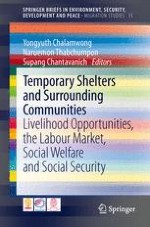This book is one of four volumes on a major empirical migration study by leading Thai migration specialists from Chulalongkorn University (Bangkok) for the United Nations Development Programme (UNDP).This volume reviews the livelihood opportunities for displaced persons in temporary shelters and in the surrounding communities. It explores labor-market conditions and provides recommendations for improving opportunities. The editors discuss the current policies of the Royal Thai Government towards displaced persons on restrictions for settlement that impede access to welfare, justice, education and health care. Service provision for displaced persons are identified here, as well as access to justice and other key services, including Thai services outside the settlements, and the potential for conflict with the local Thai population over resource allocation. Summarizing the results of a highly important research project this volume provides realistic policy recommendations for a durable solution for refugees at the borders. Policymakers from governments, international organizations and NGOs will benefit from its findings and conclusions.
